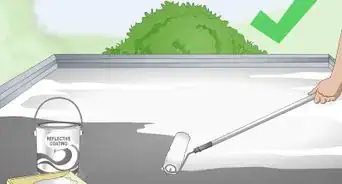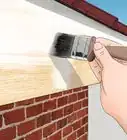This article was co-authored by wikiHow staff writer, Hunter Rising. Hunter Rising is a wikiHow Staff Writer based in Los Angeles. He has more than three years of experience writing for and working with wikiHow. Hunter holds a BFA in Entertainment Design from the University of Wisconsin - Stout and a Minor in English Writing.
There are 16 references cited in this article, which can be found at the bottom of the page.
This article has been viewed 14,884 times.
Learn more...
If you notice water leaking over the sides of your gutters, there may be something stuck in your downspout preventing it from draining. Since leaking gutters can create water damage, weaken your home’s foundation, or make walkways slippery, it’s important to unblock the downspout as soon as possible. If you want to get rid of the clog quickly, try scooping or spraying the debris out to remove the blockage. For more stubborn clogs, feed a drum auger through the downspout to break them apart. If you have the time or budget, clean or cover the gutters so they won’t clog in the future.
Steps
Scooping or Spraying out Debris
-
1Set a ladder at an angle against your home. Use an extension ladder that’s tall enough to access the top of your gutters. Move the bottom 1 foot (30 cm) away from your home for every 4 feet (1.2 m) of vertical height. Lean the ladder against your home and maintain 3 points of contact while climbing, such as 2 hands and 1 foot.[1]
- For example, if you need to climb 16 feet (490 cm), place the ladder 4 feet (120 cm) away from the building.
- Avoid climbing on your roof to access your gutters since you’re more likely to slip and fall.
- Never stop on the top rung of a ladder since you could easily lose your balance.
-
2Remove any leaves around the top opening of the downspout. Wear work gloves while you’re cleaning so you don’t scratch yourself on the gutters. Move the debris away from the downspout, which is the vertical piece of gutter running down the side of your house.
Throw out the debris in a bucket hanging on your ladder or on the ground. Pull any leaves out from the downspout hole if there are any stuck there.[2]
Move the ladder closer to the downspout if you need to lean over in order to reach it.
Some downspouts may have a screen covering the hole that could get clogged. Scrape as much of the debris as possible off of the screen.Advertisement -
3Tap along the length of the downspout with a stick to see if the clog falls out. You can use a spare piece of plywood or a tool handle to hit the downspout.
Start on the ground near the bottom of the spout and forcefully tap on the exterior sides and front of the pipe. Work your way up the length of the downspout to see if any debris falls out.
Focus on areas that have mounting brackets since they usually have screws that debris may get caught on.[3]
If you heard a solid sound rather than a hollow ringing noise after hitting the downspout, you may have found the clog. Try hitting that area repeatedly to see if the clog breaks apart. -
4Attach a leaf blower to the bottom of the downspout to blow out dry debris. Put the gutter attachment on the end of the leaf blower if you have one.
Position the leaf blower tightly inside the bottom hole of the downspout and turn it on. Let the leaf blower run for 1–2 minutes at a time and watch the gutters above you to see if debris comes out. If it doesn’t, try again for another 1–2 minutes.[4]
If you don’t have a gutter attachment for your leaf blower, put the end of the leaf blower against the bottom of the downspout. Wrap a towel around the connection and push it into the gutter to form a tight seal.- Leaf blowers don’t work as well on wet debris since it’s heavier and harder to force out.
Warning: Avoid using a leaf blower from the top hole of the downspout since you’re more likely to lose your balance on a ladder.
-
5Try spraying water from a hose up the downspout to help rinse out the clog. Use a high-pressure hose so you’re able to break the clog apart easier.
Feed the end of the hose into the bottom of the downspout until you aren’t able to put it any further. Turn the hose on and wiggle it around to help break apart the clog.
Push and pull the hose occasionally to see if you can force it up any higher. Pull the hose out when you’re finished cleaning it.[5]- If you have low water pressure, the hose may not remove the clog.
Snaking the Downspout with an Auger
-
1Insert the end of a drum auger into the bottom of your downspout. Pull the metal end, which usually has a ball or claw shape, out from the cylindrical drum of the auger so you have about 2–3 feet (61–91 cm) of line. Push the ball or claw into the end of the downspout so the line goes up toward your gutter.[6]
- Drum augers have a long metal line inside a cylindrical drum and are usually used to remove clogs in pipes and drain lines. You can buy drum augers from your local hardware store.
- If possible, avoid feeding a drum auger from the top hole of the downspout since you’re more likely to fall or compact the clog.
- If you don’t have a drum auger, you can also straighten out a wire hanger and push it into the gutter as well.
-
2Push the line as far as you can until you hit the clog. Wear work gloves while you feed the auger so you don’t scratch yourself or get pinched. Grab the base of the metal line coming out from the auger and push it up into the downspout. Continue feeding the line up until it doesn’t move anymore, which means you’ve hit the blockage.[7]
- Auger lines sometimes get stuck in bends or elbows in the gutter. Try wiggling the line around first to see if it keeps going.
- If you don’t have a long enough auger, unscrew the lowest section of the downspout if you’re able to and remove it. Place the auger into the downspout again so you’re able to reach further inside of it.
-
3Turn the handle clockwise as you push the line into the blockage. Wear gloves so you don’t pinch your fingers. Hold the base of the metal line with your nondominant hand and the handle on the back of the auger with your dominant one.
Rotate the handle quickly in a clockwise direction to spin the claw or ball on the other end of the line. Use your nondominant hand to push the line up and down and force it deeper into the clog. Continue until you don’t feel the blockage anymore.[8]- Debris and water may drain out from the downspout if you’ve removed the clog.
Variation: Some drum augers allow you to attach them to an electric drill. Screw the drill onto the auger and pull the drill trigger to rotate the auger at higher speeds.
-
4Rotate the handle counterclockwise to pull out the line and clog. Use your nondominant hand to slowly pull the line out from the gutter. As you do, turn the handle on the back of the auger counterclockwise to reel it back into the drum.
Keep pulling the line down and out of the gutter until you can remove it completely. Pull off any debris that’s stuck on the end of the claw or ball.[9]
If you’re using a drill on the drum auger, set it to reverse to reel in the line. Otherwise, you may damage the auger or drill. -
5Rinse the downspout from above with clean water. Point your hose up toward your roof and turn it on. Direct the water so it runs down your roof and into the downspout you just unclogged. Watch the end of the downspout to ensure it drains properly and water flows through it. Stop spraying water after 1–2 minutes.[10]
- If water doesn’t flow through the downspout, try snaking it with the auger again.
- If you don’t have a hose, then climb a ladder up to the top of your downspout and pour clean water down it with a watering can.
Preventing Gutter Clogs
-
1Clean your gutters twice a year to clean out potential clogs. Start cleaning out your gutters in the spring and the fall when there’s the most debris from leaves.
Climb a ladder and scoop out the leaves and debris with a trowel so they don’t travel into your downspouts. Start in the corners and work your way toward the middle. Rinse the gutters clean with your hose when you’re finished.[11]
If you don’t feel comfortable cleaning your gutters, hire a professional service to clean them for you.- Move your ladder over whenever you start leaning to reach the area you’re cleaning.
-
2Put gutter screens around downspout holes to catch loose debris. Get a raised gutter screen that’s large enough to completely cover the hole at the top of the downspout.
Climb a ladder to reach the top of your gutters, and locate the hole near the corner that leads to the downspout. Position the open end of the gutter screen inside the hole on the downspout and push it down.
Ensure that about 2 inches (5.1 cm) of the guard’s closed end sticks up from the hole.[12]
You can get gutter screens from your local outdoor care store or online. Make sure you check the shape of the downspout hole before buying a screen to ensure they’re compatible.Tip: Gutter screens still get dirty and debris around them can prevent water from flowing into the downspout. Make sure to clean the screens off whenever you clean the rest of the gutters.
-
3Install gutter covers so leaves can’t get inside the downspout. Measure the length of your gutter system with a tape measure and buy the same length of gutter covers from a hardware or outdoor care store.
Position the covers on top of your gutter system so there’s a 1⁄2 in (1.3 cm) opening between the edges. Screw the covers into the back walls of the gutter system every 2 feet (61 cm) using non-corrosive screws. [13]
Gutter covers allow water to travel through them but keeps leaves and branches from getting stuck. They come in metal or plastic. -
4Trim overhanging branches to prevent leaves from falling onto your roof. Reach the base of the branch from the ground with a long-handled tree saw. Use back-and-forth sawing motions to cut away the branch so it doesn’t hang over your roof anymore. Continue removing tree branches until you don’t have any more over your roof.[14]
- If you need to remove heavy or large branches, contact a professional service to remove them for you so you don’t damage your roof.
Warnings
Things You’ll Need
Scooping or Spraying out Debris
- Ladder
- Work gloves
- Wooden stick
- Leaf blower
- Garden hose
Snaking the Downspout with an Auger
- Drum auger
- Hose
Preventing Gutter Clogs
- Ladder
- Trowel
- Work gloves
- Gutter screen
- Gutter covers
- Tree saw
References
- ↑ https://www.osha.gov/Publications/portable_ladder_qc.html
- ↑ https://www.thisoldhouse.com/ideas/tackle-gutter-gunk-these-cleaning-tips
- ↑ https://youtu.be/dzgVZUQbQmE?t=35
- ↑ https://youtu.be/dzgVZUQbQmE?t=88
- ↑ https://www.bobvila.com/articles/spring-gutter-cleaning/
- ↑ https://www.nytimes.com/1987/09/06/nyregion/home-clinic-protecting-roof-s-1st-line-of-defense.html
- ↑ https://youtu.be/nkFf5r7dtF8?t=182
- ↑ https://youtu.be/nkFf5r7dtF8?t=189
- ↑ https://youtu.be/nkFf5r7dtF8?t=193
- ↑ https://www.bobvila.com/articles/how-to-clean-gutters/
- ↑ https://www.bobvila.com/articles/19-quick-tip-cleaning-your-gutters/
- ↑ https://www.nytimes.com/1987/09/06/nyregion/home-clinic-protecting-roof-s-1st-line-of-defense.html
- ↑ https://www.bobvila.com/articles/avoid-gutter-cleaning-forever-after-this-one-improvement/
- ↑ https://www.nytimes.com/1987/07/12/nyregion/home-clinic-q-a-cleaning-gutters-caulking-cracks-removing-paint.html
- ↑ https://www.waterboards.ca.gov/water_issues/programs/outreach/erase_waste/reduce.shtml
- ↑ https://www.osha.gov/Publications/portable_ladder_qc.html






































































